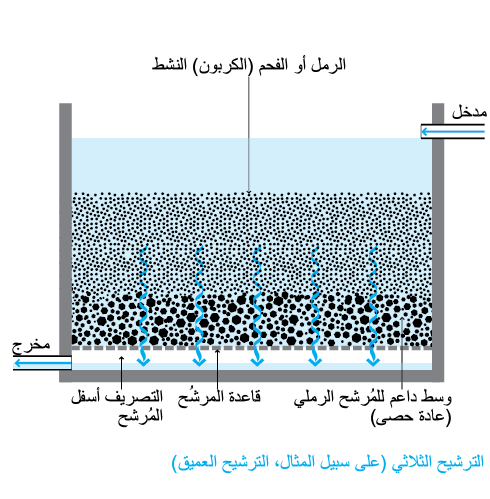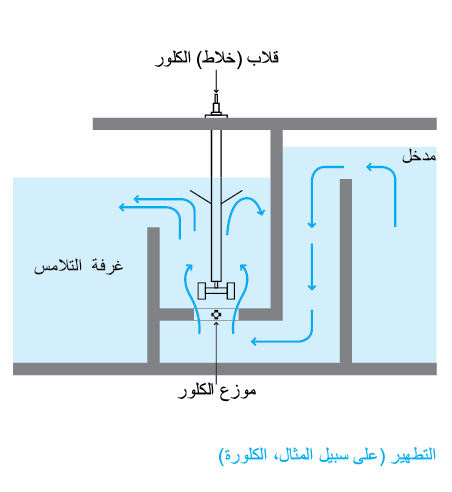المُلخص التنفيذي
اعتمادًا على الاستخدام النهائي للمياه المُعالجة أو المعايير المحلية للصرف في المسطحات المائية فإنَّ التدفقات السائلة الخارجة قد تتطلب مُعالجة لاحقة لإزالة مُسببات الأمراض والعوالق المُتبقية و/أو مُكونات ذائبة. الترشيح الثلاثي (المتقدم) وعمليات التطهير Tertiary Filtration and Disinfection هي الأكثَر شيوعًا لتحقيق ذلك.
عملية المُعالجة اللاحقة ليست ضرورية دائمًا، ويُفضَّل اتباع نهج عملي مبني على الواقع. يجب أن تتطابق جودة التدفقات السائلة الخارجة مع الاستخدام النهائي المراد القيام به، أو الجودة المطلوبة للتصريف في المسطحات المائية المُستقبِلة. تُوفر إرشادات منظمة الصحة العالمية WHO الخاصة بالاستخدام الآمن لمياه الصرف، وفضلات الجسم والمياه الرمادية، معلوماتٍ مُفيدةً عن تقييم وإدارة المخاطر المُرتبطة بالأخطار الميكروبية والمواد الكيميائية السامة. تُعتبر عمليات الترشيح الثلاثي والتطهير هي الأكثر انتشارًا من بين مجموعة واسعة من التقنيات المُتقدمة للتدفقات السائلة الخارجة.
| المُدخلات | المُخرَجات |
|---|---|
التدفقات السائلة الخارجة |
التدفقات السائلة الخارجة |

المُلاءَمَة
يعتمد قرار تركيب تقنية المُعالجة اللاحقة في الأساس على متطلبات الجودة للاستخدام النهائي للتدفقات السائلة الخارجة و/أو المعايير المحلية. بالإضافة إلى عوامل الأخرى تشمل خصائص التدفقات السائلة الخارجة، والميزانية، وتوافُر المواد، وقدرات التشغيل والصيانة.
تلتصق مُسببات الأمراض بالعوالق في التدفقات السائلة الخارجة من المُعالجة الثانوية غير المُرشِّحة؛ لذلك فإن خطوة الترشيح قبل التطهير تؤدي إلى نتائج أفضل واستخدامٍ أقل للكيماويات.
تكون المُرشِّحات الغشائية مُكلفة، وتتطلب خبرة في أعمال التشغيل والصيانة، وذلك -خصوصًا- لتجنب إحداث أي تلف بالغشاء. في الامتزاز الكيميائي للكربون النشط تتلوث مادة المُرشِّح بعد الاستخدام وتحتاج للمُعالجة أو التخلص السليم. لا ينبغي أن يُستخدم الكلور إذا كان الماء يحتوي على كميات كبيرة من المواد العضوية، وذلك خشية تكوين النواتج الثانوية للتطهير. تُعتبر تكاليف المُعالجة بالأوزون هي الأعلى مقارنة بطرق التطهير الأخرى.
الترشيح الثلاثي
يُمكن تقسيم عملية الترشيح إلى عمليات الترشيح العميق Packed-bed أو الترشيح السطحي. الترشيح العميق يشمل إزالة العوالق المُتبقية Residual Suspended Solids بواسطة تمرير الماء خلال المُرشِّح المُكوَّن من الوسط الترشيحى الحبيبي )على سبيل المثال، الرمل.( وإذا تم استخدام الكربون النشط )المُنشَّط( Activated Carbon كوسط للترشيح، فإنَّ العملية الغالبة هي الامتزاز Adsorption. الكربون النشط مجموعة متنوعة من المُركَّبات العضوية وغير العضوية، بالإضافة إلى إزالة الطعم والرائحة. الترشيح السطحي يشمل إزالة المواد الدقيقة بواسطة التصفية الميكانيكية، حيث يمر السائل عبر حاجز (غشاء) فاصل رفيع )أي طبقة المُرشِّح( وتعتبر أغشية الترشيح Membranes أيضًا من المُرشِّحات السطحية. ويجري تطوير عمليات الترشيح الغشائي مُنخَفضة الضغط )بما في ذلك المُرشِّحات الغشائية بالجاذبية( تم استخدام الترشيح العميق بنجاح لإزالة حويصلات البروتوزوا والحويصلات المُتكيِّسة )المتحوصلات(، في حين أغشية الترشيح الفائق )المستدق( Ultrafiltration يمكنها أيضًا إزالة البكتيريا والفيروسات بدرجة موثوق بها.

التطهير
يُمكن أن تتحقق الإبادة، التثبيط، أو إزالة الكائنات الحية الدقيقة المُسَببة للأمراض بالوسائل الكيميائية أوالفيزيائية أو الحيوية. يُعتبر الكلور هو المُطهِّر الأكثر اختيارًا لمُعالجة مياه الصرف على مر التاريخ؛ وذلك لانخفاض تكلفته، وتوافره بشكل كبير، وسهوله التشغيل. يؤكسد الكلور المادة العضوية، بما في ذلك الكائنات الحية الدقيقة ومسببات الامراض، ومع ذلك، فقد أدت المخاوف من أضرار النواتج الثانوية )أو الجانبية، أو المصاحبة( للتطهير بالكلور Disinfection by-products والسلامة الكيمائية إلى استبدال نظام المُعالجة بالكلور بأنظمة التطهير البديلة، مثل: الأشعة فوق البنفسجية )UV( والتطهير بالأوزون. تتواجد الأشعة الفوق البنفسجية في ضوء الشمس، حيث تقوم بقتل الفيروسات والبكتيريا، وبالتالي فإن التطهير يَحدُث طبيعيًا في البرك الضحلة غير العميقة كما هو الحال فى برك اكسدة المخلفات السائلة ويُمكن توليد الأشعة فوق البنفسجية من خلال لمبات خاصة يُمكن تركيبها في قناة أو أنبوب. يُعتبر الأوزون مؤكسد قوي، ويُمكن توليده من الأوكسجين في عملية تتطلب طاقة كبيرة. يُحلل الأوزون الملوثات العضوية وغير العضوية، ويشمل ذلك عوامل إنتاج الرائحة. مثله مثل الكلور، فإن تكوين النواتج الثانوية غير المرغوبة تُعتبر واحدة من المشاكل المرتبطة بإستخدام الأوزون كمطهّر.
الجوانب الصحية / القبول
يرافق كل من عمليات التطهير بواسطة الأوزون والكلور تكون النواتج الثانوية للتطهير، والتي قد تشكل خطرًا على البيئة وصحة الإنسان. يُوجد أيضًا مخاوف للسلامة مُرتبطة بالتعامل والتخزين للكلور السائل. الامتزاز بالكربون النشط والتطهير بواسطة الأوزون يمكن أن يزيل الألوان والراوئح غير المرغوب فيها، مما يؤدي إلى زيادة قبول إعادة استخدام المياه المُعالجة.
التشغيل والصيانة
تتطلب جميع طرق المُعالجة اللاحقة عمليات متابعة مستمرة )جودة التدفقات السائلة الداخلة والخارجة، انخفاض معدل التدفق عبر المُرشِّح، معدلات الجُرعات المُطهِّرة، ... إلخ( لضمان مستوى عالٍ من الأداء.
نتيجة لتراكم المواد الصلبة والنمو البكتيري، فإنَ كفاءة المُرشِّحات الرملية، أو الغشائية، أو مُرشِّحات الكربون النشط تنخفض مع مرور الوقت؛ لذلك فإن التنظيف المستمر )الغسيل العكسي(، أو استبدال مواد التصفية للمُرشِّح يكون مطلوبًا باستمرار. تتطلب عملية المُعالجة بالكلور أشخاصًا مُدربين لتحديد الجرعة الصحيحة من الكلور، ولضمان الخلط المتجانس والسليم. كما يجب إنتاج الأوزون في الموقع لأنه غير ثابت كيمائيًا وينحَلّ بسرعة إلى الأكسجين. وفي حالة التطهير باستخدام الأشعة فوق البنفسجية، فإن لمبة الأشعة الفوق بنفسجية تحتاج إلى التنظيف المُنتظم والاستبدال السنوي.
كراس استرشادى عن ادارة المخلفات السائلة للانشطة الخدمية محطات الصرف الصحى ووحدات المعالجة فى المؤسسات الصحية
الدليل التصميمى لمحطات معالجة مياة الصرف الصحى بالمملكة .
Language: Arabic
التلوث : المخاطر والحلول
ارشادات فى تصميم وتشغيل وصيانة محطات معالجة المياة العادمة
Tertiary Filtration
UV disinfection tank
Ultraviolet Disinfection. Guidelines for Drinking Water and Water Reuse
This document describes in detail dose, design, operation & maintenance, field commissioning and monitoring of UV disinfection for drinking water and reuse water.
NWRI (2012): Ultraviolet Disinfection. Guidelines for Drinking Water and Water Reuse. Fountain Valley (US): National Water Research Institute (NWRI) and Water Research Foundation (WRF) URL [Accessed: 20.03.2014]How to Design Wastewater Systems for Local Conditions in Developing Countries
This manual provides guidance in the design of wastewater systems in developing country settings. It promotes a context-specific approach to technology selection by guiding the user to select the most suitable technologies for their area. It provides tools and field guides for source characterization and site evaluation, as well as technology identification and selection. This manual is primarily addressed to private and public sector service providers, regulators and engineers/development specialists in charge of implementing wastewater systems.
ROBBINS, D.M. LIGON, G.C. (2014): How to Design Wastewater Systems for Local Conditions in Developing Countries. London: International Water Association (IWA) URL [Accessed: 20.01.2015]Chlorine Contact Tank
Wastewater Engineering, Treatment and Reuse
Compendium of Sanitation Systems and Technologies. 2nd Revised Edition
This compendium gives a systematic overview on different sanitation systems and technologies and describes a wide range of available low-cost sanitation technologies.
TILLEY, E., ULRICH L., LÜTHI, C., REYMOND P. and ZURBRÜGG C. (2014): Compendium of Sanitation Systems and Technologies. 2nd Revised Edition. Duebendorf, Switzerland: Swiss Federal Institute of Aquatic Science and Technology (Eawag) URL [Accessed: 03.05.2023] PDFGuidelines for the safe use of wastewater excreta and greywater. Volume II. Wastewater Use in Agriculture
Volume II of the Guidelines for the safe use of wastewater, excreta and greywater provides information on the assessment and management of risks associated with microbial hazards and toxic chemicals. It explains requirements to promote the safe use of wastewater in agriculture, including minimum procedures and specific health-based targets, and how those requirements are intended to be used. It also describes the approaches used in deriving the guidelines, including health-based targets, and includes a substantive revision of approaches to ensuring microbial safety.
WHO (2006): Guidelines for the safe use of wastewater excreta and greywater. Volume II. Wastewater Use in Agriculture. Geneva: World Health Organisation URL [Accessed: 05.06.2019] PDFSSWM Toolbox: Water Purification
Compendium of Sanitation Systems and Technologies (Arabic)
This is the Arabic version of the Compendium of Sanitation Systems and Technologies. The Compendium gives a systematic overview on different sanitation systems and technologies and describes a wide range of available low-cost sanitation technologies.
TILLEY, E. ULRICH, L. LUETHI, C. REYMOND, P. SCHERTENLEIB, R. ZURBRUEGG, C. (2014): Compendium of Sanitation Systems and Technologies (Arabic). 2nd Revised Edition. Duebendorf, Switzerland: Swiss Federal Institute of Aquatic Science and Technology (Eawag) PDFProject: Gravity-Driven Membrane (GDM) Technology
Wastewater Technology Fact Sheet Ozone Disinfection
Water Treatment System (Active Carbon Filter)
Ultraviolet Disinfection. Guidelines for Drinking Water and Water Reuse
This document describes in detail dose, design, operation & maintenance, field commissioning and monitoring of UV disinfection for drinking water and reuse water.
NWRI (2012): Ultraviolet Disinfection. Guidelines for Drinking Water and Water Reuse. Fountain Valley (US): National Water Research Institute (NWRI) and Water Research Foundation (WRF) URL [Accessed: 20.03.2014]How to Design Wastewater Systems for Local Conditions in Developing Countries
This manual provides guidance in the design of wastewater systems in developing country settings. It promotes a context-specific approach to technology selection by guiding the user to select the most suitable technologies for their area. It provides tools and field guides for source characterization and site evaluation, as well as technology identification and selection. This manual is primarily addressed to private and public sector service providers, regulators and engineers/development specialists in charge of implementing wastewater systems.
ROBBINS, D.M. LIGON, G.C. (2014): How to Design Wastewater Systems for Local Conditions in Developing Countries. London: International Water Association (IWA) URL [Accessed: 20.01.2015]Advanced Treatment by Ozonation and Sonolysis for Domestic Wastewater Reuse
This publication describes the combination of ozone and ultrasounds for the disinfection and discoloration of domestic wastewater treatment plant effluents for reuse purposes.
SELCUK, H. ; NADDEO, V. ; BELGIONO, V. (2007): Advanced Treatment by Ozonation and Sonolysis for Domestic Wastewater Reuse. المُدخلات: Proceedings of the 10th International Conference on Environmental Science and Technology: URL [Accessed: 21.05.2019]Wastewater Technology Factsheet: Disinfection for Small Systems
This document compares two types of disinfection technologies, chlorination and UV radiation. Comparison of the technologies is based on their applicability, design considerations, performance, operation & maintenance and costs.
U.S. EPA (2003): Wastewater Technology Factsheet: Disinfection for Small Systems. Washington: Environmental Protection Agency (EPA) URL [Accessed: 20.03.2014]Guidelines for the safe use of wastewater excreta and greywater. Volume II. Wastewater Use in Agriculture
Volume II of the Guidelines for the safe use of wastewater, excreta and greywater provides information on the assessment and management of risks associated with microbial hazards and toxic chemicals. It explains requirements to promote the safe use of wastewater in agriculture, including minimum procedures and specific health-based targets, and how those requirements are intended to be used. It also describes the approaches used in deriving the guidelines, including health-based targets, and includes a substantive revision of approaches to ensuring microbial safety.
WHO (2006): Guidelines for the safe use of wastewater excreta and greywater. Volume II. Wastewater Use in Agriculture. Geneva: World Health Organisation URL [Accessed: 05.06.2019] PDFGuidelines for Water Reuse
This document introduces us to the objectives and guidelines of water reuse. In describes all possible reuse application of water, technical issues in planning water reuse systems, legal and institutional issues, funding of water reuse systems, public involvement programs, guidelines in the U.S. and other countries.
U.S. EPA (2004): Guidelines for Water Reuse. Washington, DC: Environmental Protection Agency (EPA)http://water.epa.gov/
This is the weblink to the Technology Factsheets provided by U.S. Environmental Protection Agency.
https://www.watereuse.org/
This is a website for Water Reuse Organisations. They have a large data base of information and resources regarding water reuse and desalination.
http://www.youtube.com/
This video explains in detail how the chlorine is used as an element to purify water, making it fit for human consumption. It explains why this purified water is effective in preventing water borne diseases.
